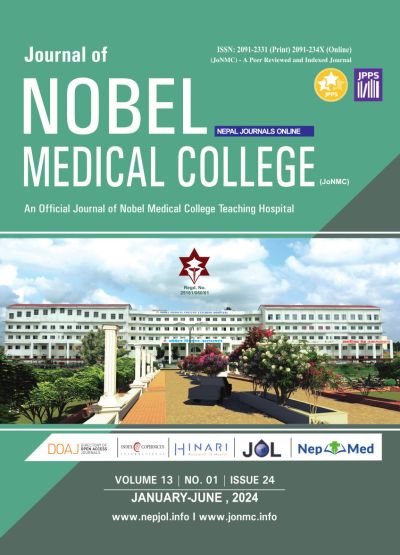Correlation between the Visual Prostate Symptom Score and International Prostate Symptom Score in Patients with Symptomatic Benign Prostatic Hyperplasia
DOI:
https://doi.org/10.3126/jonmc.v13i1.68105Keywords:
Benign prostatic hyperplasia, Lower urinary tract symptoms, Prostate specific antigen, Quality of lifeAbstract
Background: Benign prostatic hyperplasia affects about 210 million males as of 2010 (6% of the population). BPH is the most common disease of men above 50 years of age. BPH is a major cause of morbidity in the ageing men. Lower urinary tract symptoms, are a collective term for the symptoms of disrupted voiding in males, which has long been associated with BPH.
Materials and Methods: Study was descriptive cross-sectional study conducted in Department of Urology, Nobel medical college, Biratnagar, Nepal over a period from January 2022 to December 2022. The entire Patient with visiting urology clinic of the provisionally diagnosed as BEP was enrolled in the study with approval of institutional review committee.
Results: We enrolled a cohort of 75 patients who had been diagnosed with BEP. The mean age was 51.31 years. The mean prostate size among these individuals was measured to be 45.63 grams, and their mean Prostate-Specific Antigen level was determined to be 3.57.We observed a moderate positive correlation (r = 0.536) with statistical significance (p < 0.01) between VPSS total and IPSS total. Out of total, 35 (47%) completed VPSS alone without any assistance while filling IPSS only 9 (12%) could complete one. Median time for completing VPSS versus IPSS was 60sec and 300 sec respectively.
Conclusion: In assessment of symptom severity visual prostate symptom score is equally effective as International prostate symptom score in cases of benign prostatic hyperplasia presenting with Lower urinary tract symptoms. All parameters of visual prostate symptom score is significantly correlated with International prostate symptom score.
Downloads
Downloads
Published
How to Cite
Issue
Section
License

This work is licensed under a Creative Commons Attribution 4.0 International License.
JoNMC applies the Creative Commons Attribution (CC BY) license to works we publish. Under this license, authors retain ownership of the copyright for their content, but they allow anyone to download, reuse, reprint, modify, distribute and/or copy the content as long as the original authors and source are cited.




